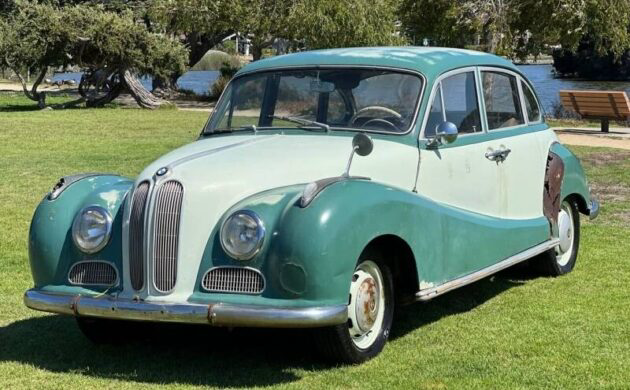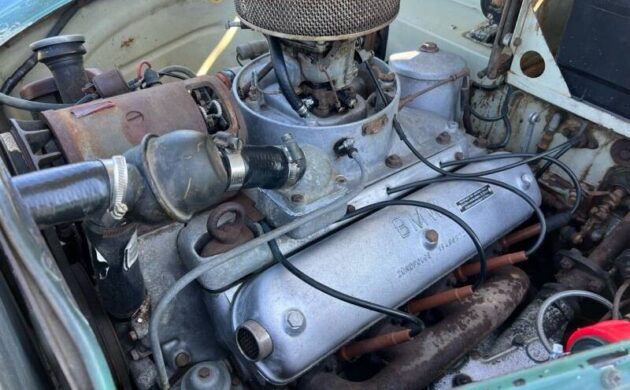In immediate post-war Germany, BMW didn’t make cars. Instead, Soviet manufacturer Autovelo, located in Soviet-occupied territory, was producing pre-war BMWs to sell into the post-war market. BMW itself was slow-crawling its way back to prosperity, by making household kitchen items, then bicycles, then motorcycles. Autovelo continued making “BMWs” until 1949 when it lost the legal right to continue. Shortly thereafter, BMW introduced its first real post-war design, the 501. Powered by a six-cylinder motor, and styled with swooping, rounded fenders, the car was lovely but painfully slow. It was also an expensive luxury car at a time when buyers were still scarce. In 1954, BMW upgraded the motor to a V8. This car was called the 502. Its body was nearly identical to the 501, but it offered better trim, separate driver and passenger seats, and fog lights. Production for both series was estimated at 22,000 units. Here on craigslist is a 1960 BMW 502 sedan, with an asking price of $20,000. The car has at least one Concours d’Lemons award and an acquaintance with Wayne Carini to its name; it is located in Monterey, California. Thanks to T.J. for this wonderful tip!
BMW was selling at least two derivatives of the 502 by 1960 – the Lexus and the Super. The Super had a larger 3.2-liter motor with twin Zenith carburetors and at least 120 bhp (some sources say 160 bhp for a higher compression version of this set-up); the Lexus continued the use of the 2.6-liter motor from earlier years with a single Solex and 100 bhp. This car has the smaller engine, but at least it does run and drive, as seen in this video. But – forewarned is forearmed – it doesn’t stop! No one has attempted repair on the brakes yet.
The interior is showing its age, though the seats are decent. The suicide doors are emblematic of the times. This photo shows the gearshift on the column for the four-speed manual. Fortunately, all the trim seems to be present since parts will be difficult to find.
Rust has invaded this Bimmer’s body. Its undercarriage has not escaped the tin worm, either. This photo shows its rounded but also rotund lines; its appearance earned it the nickname “barockengel”, translating to “baroque angel”. The car was designed in-house at BMW, but management was apparently underwhelmed and elicited a submission from Pininfarina. The result was considered too similar to a contemporary Alfa Romeo, so the factory reverted to the original design. This 502 is accompanied by several documents, including a scarce owner’s manual. Comparable cars are impossible to find in the US, but several restored examples are for sale overseas at the equivalent of $50k to $70k. The presence of rust complicates matters for this car. If I owned it, I would feel obligated to fix that problem; what do you think?






A couple of small nits to pick in this excellent writeup: first, the East Germans continued to build prewar BMWs into the mid-1950s under the “EMW” (Eisenach Moteren Werke) name. Don’t recall the exact date they stopped, but they built a limited number of passenger cars and even a couple of racers. Also, the 502 models were “Luxus” (not Lexus) and Super. At least for a while, the factory was building both 501s and 502s; the latter was a supplementary model.
These were actually pretty decent cars. Comfortable, if not spectacular. I drove a restored example some years ago, and enjoyed it. I’ve seen maybe a half-dozen in the States.
Even though it would be a labor of love and not an investment, I’d love to see this one restored.
Yes, what I said was Autovelo could no longer make “BMWs”; you are right, they slightly changed the name and actually the color of the badging, and continued on.
Excellent write up, Michelle. Crisp and efficient. I knew nothing about these and you gave a great overview. Ray’s picked nits notwithstanding, you’re good.
It’s the profile view that feels like a near miss. Too rotund, as you say. That 1/4 view promises, but the profile disappoints. The trunk like doesn’t help.
Thanks! …. Despite the dumpling proportions, in the right colors the restored versions are beautiful.
The BMW factories were divided by the iron curtain post war, During the war BMW motorcycle production was based in Eisenach in the east.. At wars end they continued to build prewar model BMW motorcycles badged as BMWs until forced to convert to the EMW badging in 1951. These BMW R35 motorcycles were built in the old BMW factory that ended up in the Soviet zone by mostly ex BMW employees . The BMW factory in the west was not yet producing vehicles. In 1951 BMW in the west was given full use of the BMW trademark and the Eisenach factory switched to using EMW.
Here’s the EMW logo and face – note the similarities with BMW as the double kidney grille and badge. While some seem to think the blue/white BMW propeller- traditional Bavarian color combo – was tweaked to include ‘communist red’ in the almost identical EMW badge, the red/white are actually the colors for the region Thüringen in which Eisenach is located
https://classicsweb.wixsite.com/classics/single-post/2017/08/14/emw-the-eastern-bmw
Thanks for the link! Very educational piece, I was totally ignorant in this area of automobile history.
I love the BMW 502. I think it’s a lovely looking car. Patina and all. I’d buy one if it were for sale here in Washington state. Given its rarity and condition, I’d pay between $15k and $20k. Assuming everything works like it should, I can see this being a good daily driver on beautiful days.
Great educational write up.
That “Concours d’ Lemons with Wayne Carini is the definition of smug.
The 501/502 very nearly bankrupted BMW. They were expensive to produce and sold in low numbers. The car that saved BMW was the lowly Isetta.
True story. These cars were a very bad idea at the time,, even if (in my opoinion)) handsome. The 503 convertible was stunning. The Isetta kept the lights on, but what gave them a much needed shot in the arm was the 700-series. The 700 sports coupé , designed by Michelotti, was as handsoome and as reliable as could be.
If in fact a decently restored example can be bought for $70,000, the “seller” would need to give the car and at least $20,000 to the ” buyer” so he had a chance of not winding up underwater . . .
What I see from the pic of the 502 Dashboard is a distinct similarity to my ex 1959 Borgward Isabella. Would there have been a connection Michelle?
Very astute. You have found evidence of a link that may remain a mystery forever. The facts surrounding the BMW/Borgward connection are apparently in German and many of the workers who may remember what happened are gone or scattered. However, this article sheds some light on the nefarious circumstances of Borgward’s bankruptcy, and casts aspersions toward BMW for stealing Borgward’s intellectual property:
https://petrolicious.com/articles/the-borgward-brand-is-back
Bristol of England were building and selling BMWs under their brand from 1948 to 1955 or about that.
The cars Bristol built were not BMWs, although they were based on BMW drawings, with help from an ex-BMW engineer.
I had the opportunity to drive one about 40 years ago…when it was about 30 years old…I stagger to think now that it was as old then as as my Miata is now…but I digress.
I wrote it up for AutoWeek and have republished it, if providing a link is permitted: https://rememberroad.com/what/bmw/bmw-502-delicate-sparkle-of-a-bavarian-princess/
This would be a beautiful car once restored. However, with the amount of work needed to restore this one $10K seems to be a more reasonable price. $20K seems to be throw a price up on the wall and hope it sticks deal.
I found a similar Baroque Angel back in the early 80s, it was the 3.2 V8, and had BMW 3200 badging on the trunk lid [but it wasn’t the CS version, it was a 4-door sedan]. On the outside, it was a beautiful dark blue car with low mileage. Bought it for just under $1,000. It had all the original paperwork showing it was sold new by Hoffman in New York.
Sadly, the car had been parked on top of a damp gravel driveway for years. I discovered the ladder type frame had massive main rails, constructed with oval [not square or round] tubes. Both the long tubes on my car were severely rusted, and the amount of work required to make the car safe to drive was more than I wanted to do at the time, because 40 years ago almost nobody wanted a BMW 502.
I’ve always regretted the sale of that BMW.
Living in Germany in the late 60s, these 502s could be bought for USD 200. They got poor gas mileage, and secondary owners couldn’t afford to feed them. Nobody wanted them.
Looks like a 4 door DKW to me !